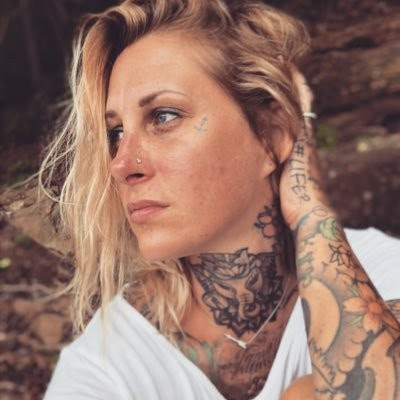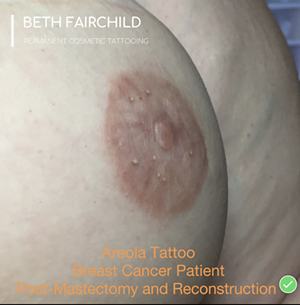Beth Fairchild is a medical tattoo artist and breast cancer activist who has been in Cincinnati for several days helping to train staff and practitioners at the University of Cincinnati Cancer Institute on the art of 3D areola tattooing for women who have undergone mastectomies and breast reconstruction surgery.
Fairchild was diagnosed with metastatic breast cancer in her 30s and has used her own diagnosis and her family history of the disease — her mother was diagnosed with Stage II breast cancer and her grandmother died from breast cancer — along with her experience in the tattooing industry to both educate and advocate for those with metastatic breast cancer and also assist those who have undergone reconstructive surgery by applying and training others to better apply 3D areola tattoos.
In addition to training at UC, Fairchild will also be the keynote speaker at a public reception for National Breast Reconstruction Awareness Day with the UC Cancer Institute's Breast Cancer Center from 5-7 p.m. on Oct. 16. Her talk is titled “Medical Tattooing and the Art of 3D Areola Nipple Tattoos” and it will take place 6 p.m.
The event will be held at the UC Gardner Neuroscience Institute's first floor auditorium (3113 Bellevue Ave., Clifton) and will offer those who attend a chance to hear Fairchild speak about her experience as a person living with breast cancer and as a tattoo artist. Guests will also have a chance to interact with breast cancer and mastectomy and reconstruction support groups.
We chatted with Fairchild via email in advance of her keynote about her activism and the art of 3D tattooing.
CityBeat: Can you explain what it was like to receive a cancer diagnosis at 34? And can you explain what metastatic breast cancer is for readers who might not be familiar?
Beth Fairchild: Metastatic breast cancer, or MBC, is breast cancer that is now growing in distant sites, outside of the breast, most commonly (in the) bone, liver, lung (or) brain and is considered Stage IV and terminal. It was very scary to be diagnosed with MBC. The fear, anger, sadness and grief were overwhelming. It was also very isolating because metastatic breast cancer patients aren’t really supported by most larger breast cancer organizations, especially 5 years ago when I was diagnosed. That has changed somewhat today, but we still have light years to go.
CB: As part of your treatment, did you undergo a mastectomy?
BF: I did. Although I never experienced a lump in my breast, I felt like there could be the remanent of a primary tumor or that I would develop a secondary breast tumor that could potentially feed distant metastasis. I was young and had large, dense breasts. When I chose a mastectomy, I had to advocate for my surgery and educate my medical team about the risks versus benefits for an MBC patient. I have no regrets. After three years of living totally flat, I chose to reconstruct my chest.
CB: Had you been involved in the tattooing industry before your diagnosis? If so or if not, what inspired the move toward medical tattooing?
BF: I’ve been in and around the tattoo industry for over 20 years. It has been my career. Although tattooing is now more difficult for me, I can still work in small sessions and teach others to do what I do (like I’m doing in Cincinnati at UC), and to help women feel whole again. I started doing areola tattooing for BC patients in 2011, 4 years before my own breast cancer diagnosis.
CB: Can you explain what the term "3D" tattoo means? Are the tattoos just for women who have undergone reconstruction?
BF: Medical tattooing can be for anyone. We can create nipples, cover scars, camouflage vitiligo, even create the appearance of hair, either on the head for someone with hair loss or eyebrows using tiny hair strokes. Areola tattooing is primarily for women and men who have lost their natural areolas to mastectomy, but in some cases, it’s needed after reduction or chest reconstruction during gender reassignment. 3D tattoos are just basic, high-quality tattoos, using dark and light to create contrast and give the the illusion of a nipple protruding from the breast mound.
CB: Can you speak to the impact these tattoos have had on women you've tattooed? Is there a particular story you remember?
BF: I once tattooed a woman who lived with breast mounds for 23 years. No nipples, just implants — we call them "Barbie breasts." She refused to look into the mirror when she undressed because she hated her blank chest. After her procedure, she looked into the mirror and said, "I feel like a whole woman." It’s always an emotional experience. Women have gone through so much when they get to me and I sort of get to put the icing on the cake — the final step in the process.
CB: What about the concept of "tattooing?" (Which can) seem taboo to some women. Especially of an older generation?
BF: Tattooing actually used to be illegal in many states and was thought of as a seedy, back-alley kind of thing. Lots of military men and loose women had tattoos, as well as prison inmates and bikers, giving tattoos a somewhat scary connotation. Of course, during the '70s and '80s, before HIV and Hep C were really on the scene, lots of cross-contamination happened leading to infections and illnesses, but those days were born out of ignorance. People just didn’t know the risks that we are aware of today. Tattooing has a rich history, dating back thousands of years, steeped in artistry and tradition. Even the "Ice Man" discovered mummified, buried for centuries, had multiple tattoos. In 2018, it was estimated that 30 percent of the general population are tattooed and around 50 percent of the GenXers. Tattooing is more mainstream than ever before and because of that there are better standards in safety and sterilization practices, higher quality products available to artists and a greater level of artistry and skill available.
CB: Do you ever do tattoo work for women who have not had reconstruction but still want artwork over surgical scars?
BF: I do, sometimes. As a patient myself, chemotherapy left me with peripheral neuropathy and tattooing has become difficult, especially when working in large areas and for long periods of time.
CB: How do you feel the application of art — be it through the 3D medical tattooing or otherwise — allows women to gain some empowerment over the changes that have happened to their bodies?
BF: I think breast cancer makes us feel like we’ve lost control of our bodies. Our bodies turn against us; all we can do is follow the standard of care and hope for the best outcome. Deciding on reconstruction options (which is very much an art preformed by a plastic surgeon), areola tattooing or tattoos that cover scars from surgery, are choices patients can make — time when the patient has total control of what they do or don’t do to their bodies. As artists who contribute to this step in the process, we are responsible for delivering a good result and for making it a positive experience for the patient.
CB: For the training, are you training tattoo artists or medical professionals? Can you explain the training process?
BF: I will be training hospital staff at the UC Cancer Institute who work alongside patients in the clinical setting. Many people working in hospitals and plastic surgeon's offices are already doing these types of tattoos, but not as well as they could. My job is to make them more effective so that they can provide a higher level of service and care. Our training will cover a variety of different topics, from the history of cosmetic tattooing to color theory to versatility of the pigments, and will include practical sessions where the trainees will be tattooing and interacting with actual patients. We go beyond the skill of tattooing and also talk about how you talk to breast cancer patients.
Fairchild is currently still undergoing regular chemotherapy treatments, according to her bio, and owns five tattoo studios with her husband. You can follow her journey on instagram at @bethfairchild.







